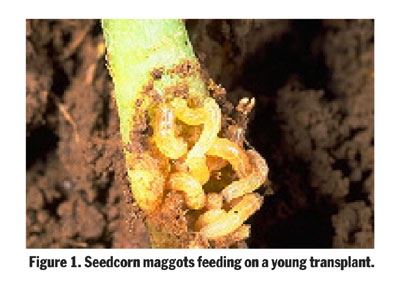Seedcorn Maggots And Cool Wet Weather
LEXINGTON, KY.
Commercial producers
and home gardeners
have struggled to get
their ground worked and
crops planted this the spring
and those that did get planted
have been slow to grow due to
cool soil temperatures. Seedcorn
maggot is a pest favored
when ground is worked just before
planting/transplanting, heavy cover crops, and
cool-wet weather. Cool soil temperatures slow
seed germination and plant growth and keep
seeds and young plants vulnerable to seedcorn
maggot. When stand loss or plant injury due to
seedcorn maggot becomes apparent, there are
no effective rescue treatments available.
Although the seedcorn maggot feeds primarily
on decaying organic matter, they will feed on
seeds and seedlings of soybean and field corn,
but most of this seed is protected with insecticide
seed treatments. They also attack a wide
range of vegetable crops including beans, peas,
cucumber, melon, onion, corn, pepper, potato
and other vegetables. Seedcorn maggot eggs are
laid just below the soil surface in tilled ground
that is high in organic matter. The flies can
often be seen running over the soil surface just
after cover crops have been turned under. The
maggot is yellowish white and about 1/4 inch
when mature. The body is legless with a pointed
head and a blunt tail. After about 21 days, the
larvae pupate in the soil.
The brown pupal cases are hard and football-shaped
and are found in the soil near the roots.
The adult is a dark gray fly with smokey-gray
wings, black legs, and three stripes on its back.
It resembles a house fly. They overwinter in the
soil as pupae. When the soils warms in the
spring, adults emerge, mate, then search for
suitable host plants for egg laying. While there
are 4 to 5 generations per year, it is the first and
second that can cause serious damage.
Seedcorn maggots damage newly planted
seeds by feeding on seed contents. Often the
shells of the seeds are empty and germination is
greatly reduced. Seedlings that do emerge are
spindly with few leaves. Occasionally, seedcorn
maggots tunnel seedling stems.

Attack is most severe when moist, cool spring
conditions contribute to delayed, slow germination
and emergence.
While seedcorn maggots can severely reduce
plant populations, there are a number of other
factors that can reduce germination. If seedcorn
maggots are suspected, carefully dig up the
seeds in the row skips and examine them for evidence
of seedcorn maggot damage. Damage
may range from a few meandering tunnels in
the seeds to the entire contents of the seed destroyed.
Cotyledons and first leaves of the remaining
seedlings may be deformed or spindly.
Cutworms, wireworms, and white grubs are
other insects that can contribute to stand loss.
Management
Crops planted early when the weather is cool
and wet for long periods of time are potentially
at greater risk to damaging infestations. With
this insect, planting in well prepared seedbeds,
planted sufficiently late for quick germination is
one means for preventing injury. Where possible,
heavy cover crops should be turned over
early (two or more weeks before planting) to render
the field less attractive to egg laying seedcorn
maggot flies in the spring. Depending on
the crop, insecticide treatments at planting,
transplant water, or even seed treatments may
be available to control these insects. After damage
is observed on the crops, rescue treatments
are not usually effective. Resetting or replanting
of crops may be necessary if stand loss is severe.
Occasionally, crops are seeded when soil temperatures
are below those for optimal or rapid
germination. Shallow planting will increase germination
rates and aid in speeding up germination
and reduce losses to seedcorn maggots.
Under these conditions, higher seeding rates
should be considered to offset stand loss. Δ
DR. RIC BESSIN: Entomologist, University of
Kentucky